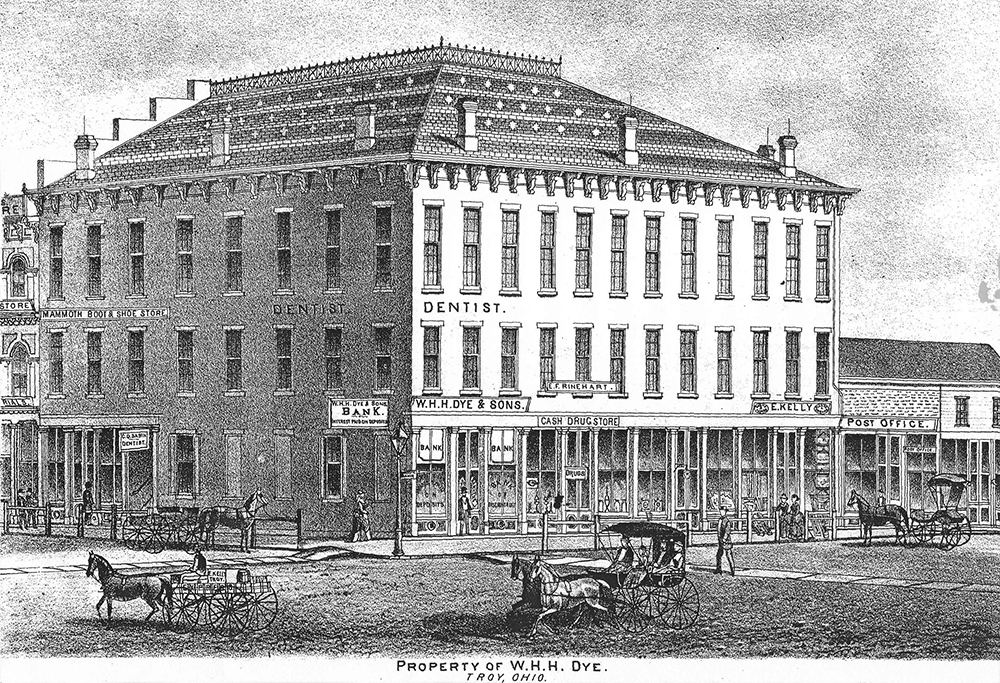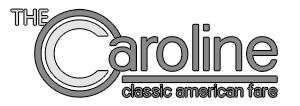
This building is located at the southeast corner of Troy’s public square on portions of lots 46 and 57. In 1864 W.H.H. Dye began buying parcels of these lots and in April of 1865 had purchased all of the land he needed to build this 80′ X 73′ three-story building. It has been said that the building was completed early in the year of 1866. Notice that the third floor of the building has much taller windows than the other two floors. This is because the third floor was constructed as a public hall, Dye’s Hall. Reportedly the hall has two ballrooms with 34′ high ceilings. Many of the public school exhibitions, lectures, plays and social events previously held in Mayo’s Hall were moved to Dye’s Hall when it was completed. (Henry Mayo and W.H.H. Dye were brothers-in-law.)
 W.H.H. Dye’s full name is William Henry Harrison Dye. He was born the day after Christmas in the year 1813 and is named after this famous general who a couple of months earlier had
W.H.H. Dye’s full name is William Henry Harrison Dye. He was born the day after Christmas in the year 1813 and is named after this famous general who a couple of months earlier had
Defeated the British and Indian forces during the Battle of the Thames. William was born in Staunton Twp. and at age 16 moved to Troy where he gained employment as a clerk. In 1839 he married Miss Martha Culbertson and the following year purchased the Bosson Brothers’ Mill south of Troy in partnership with his father-in-law and three brothers-in-law, whose interests he later purchased. William converted the flour mill into a distillery and made a small fortune selling spirits during the Civil War as whiskey prices had soared during that time. After the war ended he stopped distilling, before the price of whiskey dropped, and converted the distillery back to a flour mill. In 1877 he began processing linseed oil; the mill was at that time being operated by his son and son-in-law. Ten years later William sold the mill property, and its accompanying pond, which was located off of Dye Mill Rd. which branches off of E. Main St. and connects with County Rd. 25A at the north end of Waco Field.
W.H.H. Dye was likely the wealthiest man in Troy after the Civil war and also at the time of his death in 1900. He lived at the southeast corner of Franklin and S. Market streets in a large 2- story dwelling. After going into semi-retirement in 1865 William spent time wisely investing his fortune. This building was likely constructed as one of those good investments. Early on this building housed the Mammoth Boot & Shoe Store, C.Q. Sabin’s dental office, the E.F. Rinehart Cash Drug Store and Mr. Eli Kelly’s book and stationery store which also specialized in the sale of musical organs. In 1871 he established W.H.H. Dye & Son, Troy’s first private bank, which was located on the ground floor in the northwest corner of the Dye building. Eight years later he sold the bank to a Dayton firm and the bank eventually became known as the Miami County Bank. There remained a bank in this location until ca. 1900. During the 1880’s the Knights of Pythias met on the third floor of this building and every two weeks the Troy Dancing Club, a men’s organization, held dances here. As the space was so grand, the largest balls in town were held here, including masquerades, Firemen’s balls and New Year’s Eve balls.
From as early as 1875 there was a drugstore at 3 S. Market. These stores include: E.H. Rinehart Cash Drug Store, N. Tobey & Son, Chas. W. Tobey and the Magoteaux drug stores. 5 S. Market St. has been the home of dry goods stores including James Grunder & Co.; by 1911 it was the location of a 5 & 10 cent store. As early as 1927 G.C. Murphy & Co. had opened here and was in business until the early 1970’s. 7 S. Market St. has housed books and stationery shops, groceries and for many years was the location of a hardware store. These stores include: H.L. Hatfield & Bro., Hatfield & Scott and the Ralph Gibson hardware stores.
For many years G.C. Murphy and Co. occupied the entire ground floor of the Dye Building. In 1941 the store was robbed by a man from Peru, Indiana. The man had reportedly been in Dayton, Ohio looking for a job where he came up with the idea to stage the robbery. He pulled it off and escaped back to Indiana. However, the manager of the store, Earl Davis, was able to describe his likeness to the police who subsequently arrested him. Mr. Davis traveled to Indiana to verify his identity.
When G.C. Murphy closed their doors around 1971, the building became vacant. For most of the 1970’s and 1980’s, most of the building was deserted except for a business here and there on the 1st floor; the 2nd and 3rd floors ‘of this building were likely deserted even longer. In 1987 7 S. Market became the home of the Upper Krust restaurant which was replaced the following year by Taggarts restaurant which remained at this location until the spring of 2007 just prior to the sale of the building to Tony Blundell of the Medallion Investment Group which planned to renovate and restore the building. In January of 2008 the Caroline restaurant opened its doors and the 2nd floor $600,000.00 renovations were completed in December of that year. The second floor renovation included the construction of an elevator and division of the space into four office suites.
